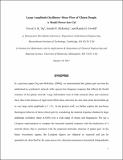Large amplitude oscillatory shear flow of gluten dough: A model power-law gel
Author(s)
Ng, Trevor S. K.; Ewoldt, Randy H.; McKinley, Gareth H
DownloadNg_glutenLAOS.pdf (3.555Mb)
OPEN_ACCESS_POLICY
Open Access Policy
Creative Commons Attribution-Noncommercial-Share Alike
Terms of use
Metadata
Show full item recordAbstract
In a previous paper [T. S. K. Ng and G. H. McKinley, J. Rheol.52(2), 417–449 (2008)], we demonstrated that gluten gels can best be understood as a polymericnetwork with a power-law frequency response that reflects the fractal structure of the gluten network. Large deformation tests in both transient shear and extension show that in the absence of rigid starch fillers these networks are also time-strain factorizable up to very large strain amplitudes (γ∗>5). In the present work, we further explore the nonlinear rheological behavior of these critical gels by considering the material response obtained in large amplitude oscillatory shear over a wide range of strains and frequencies. We use a Lissajous representation to compare the measured material response with the predictions of a network theory that is consistent with the proposed molecular structure of gluten gels. In the linear viscoelastic regime, the Lissajous figures are elliptical as expected and can be quantitatively described by the same power-law relaxation parameters determined independently from earlier experiments. In the nonlinear regime, the Lissajous curves show two prominent additional features. First is a gradual softening of the network indicated by the rotation of the major axis of the stress ellipse. This feature is accounted for in the model by the inclusion of a simple nonlinear network destruction term that reflects the reduction in network connectivity as the polymer chains are increasingly stretched. Second, a distinct upturn in the viscoelastic stress is discernable at large strains. We show that this phenomenon can be modeled by considering the effects of finitely extensible segments in the elasticnetwork. We use this model to quantitatively predict the material response in other large amplitude transient flows such as the start-up of steady shear and transient uniaxial extension up until the onset of strongly nonlinear unsteady phenomena such as edge fracture in shear and sample rupture during extension.
Date issued
2011-03Department
Massachusetts Institute of Technology. Department of Mechanical Engineering; Massachusetts Institute of Technology. Hatsopoulos Microfluids LaboratoryJournal
Journal of Rheology
Publisher
American Institute of Physics
Citation
Ng, Trevor S. K., Gareth H. McKinley, and Randy H. Ewoldt. “Large Amplitude Oscillatory Shear Flow of Gluten Dough: A Model Power-Law Gel.” J. Rheol. 55, no. 3 (2011): 627.
Version: Author's final manuscript
ISSN
01486055